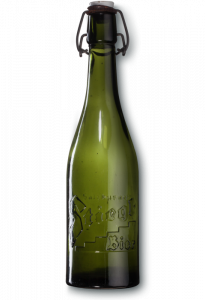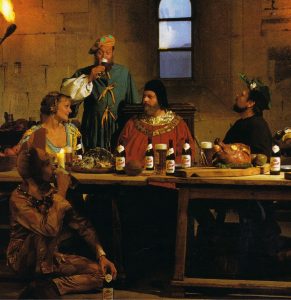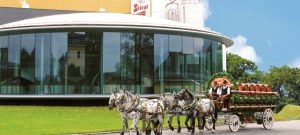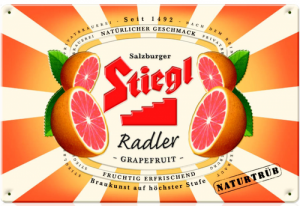54 Stiegl

Introduction
Since 1492 Stiegl beer has been long-standing as Austria’s most successful brewery. They are a family-owned business and have owned it for over 120 years and pride themselves on their slow brewing process. The beer was initially brewed in downtown Salzburg, which then changed to the Maxglan area of Salzburg during the late 19th century. The slow brewing process is a seal of quality created by the beer market to represent the strictest award criteria, ultimately leading to high-quality beer. As it says in the name, “slow brewing,” meaning there is a more extended time associated with the brewing process, but this is what the business has been able to pride itself on when compared to other brewers. After all, they have been Austria’s most successful brewery for a reason. They focus on nurturing organic soils to ensure they produce the highest quality grain and hops. And despite the rapidly changing times and new technologies emerging, they are committed to their principles of circular ecological economy.
Origins
If we go back a few centuries to the year 1492, that is when “The House by the Steps” is first mentioned in a document dated June 16th, 1492. The well-known company name of Stiegl is introduced a few years after this occurrence. “The House by the Steps” was where customers would drink their home-brewed beer and eat food from the local farm, which was the old business operation. The customers could then take home pitchers or tankards of beer after enjoying their evening. Fast forward to 1650, and Stiegl becomes the biggest brewery in Salzburg. They had their fair share of competition, of course, with over 100 other brewers targeting the same customers; however, other brewers faced transportation issues and shortages of goods, which gave Stiegl an advantage as they brewed locally and harvested the majority of supplies themselves. During the 1600s, there was also excessive drinking as people would get together to drink, smoke tobacco, and talk about their lives. This was another advantage for Stiegl and contributed to their successful growth. Enjoying the malt and hops beverage became the new custom for the majority of the residents during that time and centuries after that.
Here is a video giving you a tour of Stiegl’s history:
Milestones
- In 1492, “The House by the Steps” is recognized in a written document for the first time. The guest house becomes a popular location for the nearby community to enjoy an evening of drinking beer and eating delicious food also prepared by the house.
- In 1650, Stiegl’s popularity grows to the point of being the biggest brewery in Salzburg. Despite their local and imported beer competition, post people preferred their brewing process and taste it delivered.
- In 1780, “Mozart drinks Stiegl beer”. It was read from a diary entry made by Mozart’s sister that writes: “At 3 o’clock we go to the Stieglbrau to watch the skittles.”.
- The year 1820 is when Stiegl’s brewery owner modernizes the brew house by purchasing a storage cellar and storing it underneath Salzburg’s castle. They then serve the beer in the garden above the cellar, where it still remains in operation today.
- In 1863, Stiegl expands and moves out of the narrow streets in the city to the district of Maxglan where they open up a modern business for the first time.
- In 1875 an unfortunate event happens that sends the new brewery up in flames. The fire happens after thirteen years of operation; however this does not discourage the owner of Stiegl. Instead, he immediately starts rebuilding and only a few months later is producing larger quantities of the beer than before.

Family Owned Since 1492 – “https://www.stiegl.at/en/the-brewery/private-brewery/history/”
Brewing Science and Industrialization
The Industrial Revolution positively impacted beer drinkers’ experiences. Industrialization also positively impacted brewing technology, like the use of steam power, which generated more jobs as brewers moved to cities and changed their ways of brewing (Christiane Baum, The Stiegl Brewing World 2022). The creation of steam power led to the steam engine, “The steam engine allowed for the easier transportation of materials, better brewing processes, and easier distribution of beer” (History of beer part 2: Beer and the Industrial Revolution 2020). Stiegl Brewery capitalized on some equipment changes, which enabled them to grow from a small brewery to Austria’s most successful private brewery (Christiane Baum, The Stiegl Brewing World 2022). However, it stayed true to its naturally resourced ingredients. Stiegl’s home brewery, located in Salzburg, Austria, is one of the most beautiful breweries in the world (Global Beer Network, Stieglbrauerei 2022). The brewery has one of the most admired fresh-water supplies globally and makes up for 92% of Stiegl beer (Global Beer Network, Stieglbrauerei 2022). This is one significant example of how Stiegl brewery, during industrialization, was able to capitalize on necessary equipment changes while still utilizing original methods of harvesting critical ingredients. Stiegl Brewery also prides itself on its conformity with the German Purity Law, which states that only barley, hops, and water are the only ingredients used in the brewing process (Christiane Baum, The Stiegl Brewing World 2022). All of the hops and grains that are used by the brewery are sourced from Austria (Global Beer Network, Stieglbrauerei 2022).

Brewery located in Austria – “https://www.globalbeer.com/breweries/stieglbrauerei/”
Beer Style
On June 16th, 1492, the brewhouse in Salzburg was first mentioned in a written document. The name Stiegl (meaning “small steps”) originates from the finding of the brewery house. These are the small steps that lead up to the brewhouse. Behind the brewhouse is where the freshwater was fetched for the city and became the brewing water supply. Back then, they had a much simpler method of brewing: the brewer would brew his beer, slaughter his animals, and provide a service to customers who eat and drink in his brewhouse. The brewer would then use the consumer income to purchase supplies for personal and business needs.
Considering that it was during the end of the 15th century, the brewer was one of the only brewhouses within walking distance for the townspeople, which positively impacted the return of frequent customers and income. The townspeople would also drop by just for a drink after work or take tankards of beer home. (History – goldrichtiger geschmack! 2022).
In the 17th century, there were over 100 brewers producing beer in Salzburg. Despite the increase in competition, Stiegl brewery remains at the top with “the highest-capacity brewery among the twelve in the city” (History – goldrichtiger geschmack! 2022). “The brewing copper at the Stiegl Brewery has a capacity of 17 buckets, just under 1,000 liters (264 gallons). Despite this, the Pierprew of 1664 brews 1,800 buckets of beer, corresponding to around 100,000 liters (26,417 gallons)” (History – goldrichtiger geschmack! 2022). Considering this was the 17th century, this was considerable volume being created.
The WWI and WWII Era
Stiegl was hit hard during the first world war. They suffered drastic drops in sales, which led to slower production and not as much capital gain. They slowly began to recover closer to the 1920s. They quickly gained private access to the Stieglbahn, used to transport beer. This increased their customers as they could transport their beer to further away locations at a fast pace. Four years later, Stiegl beer has become one of Salzburg’s most popular beers to drink. Then in 1929, the stock market crash drastically impacted the brewery, followed by the invasion of German troops in 1938. These unfortunate events led to an economic decline that affected all businesses (Stiegl 2020).
There was a similar decline in production after the second world war. The beer’s quality had declined due to insufficient resources and the availability of ingredients. They tried to make do with the ingredients they did have but could only produce 67,000 liters of thin beer (Stiegl 2020). The Stiegl brewery was able to make a second recovery by 1948. This was due to an increase in raw materials, which enabled Stiegl brewery to produce high-quality beer again (Stiegl 2020). Stiegl brewery began making and selling coasters with their label reading “Brewed and bottled in the Stiegl brewery.” (Stiegl 2020). The brewery continued to grow and succeed past its previous hardships and would continue to be passed down from generation to generation. With each pass over, the business grew into one of America’s most successful brewers (Stiegl 2020).
Consolidation
Stiegl brewery was able to outlast both post wars. They were able to recover as a company and capitalize on the most recent changes. The brewery did suffer sharp drops and suffered from economic hardship during the 1910s and again roughly 35 years later.
After the First World War, Stiegl brewery slowly started to recover again from 1920 to 1925 (Stiegl 2020). “From 1920 the brewery had its connection to the Austrian railway network via the so-called Stieglbahn, which made it much easier to transport beer. In 1924, every second beer drunk in Salzburg was a Stiegl. From 1921 to 1925 the empty farm buildings of the Maxglan brewery were rented to the Salzburger Kunstfilm, Salzburg’s first film company, which set up film studios and a laboratory inside it” (Stiegl 2020). Unfortunately, the stock market crash brought the brewery’s sales down again and limited raw materials which slowed down production.
After the Second World War, Stiegl’s production was severely impacted. Even the low supply that they were able to produce was thin beer which was a result of the poor supply chain (Stiegl 2020). Then, in 1948, raw materials began to become more available (Stiegl 2020). This allowed the brewery to restore the high-quality beer that they would normally produce. “With the note “Brewed and bottled in the Stiegl brewery” on labels and coasters, reference is made to the production of “American” beer in the Stiegl brewery” (Stiegl 2020).
Marketing and Branding
Due to the fact that the brewery has been around for centuries, their marketing and branding over the years has fluctuated as they always strive to keep their existing customers, while also including first time buyers. When the company first started out in the 1800’s, their marketing and branding was essential during the initial stage of growing their brewery. As the years went on, they would continue to become a well-known beer brand as majority of the locals would be drinking Stiegl over other imported beers. The breweries main focus was the locals in town, as they served as a meeting place for people to come and drink and enjoy a home cooked meal. As the years went on, Stiegl Brewery went through many ups and downs. They include successfully getting through two world wars, the economic depression, and many more. Despite the challenges the brewery faced, they continued to rise to the top every century. Fast forward to the most recent changes, Stiegl has become a world-wide known and loved beer brand, while still holding their original cultural value in Salzburg, Austria.
As for their logo and branding of their beer, it has also evolved over the centuries. Originally, they had a more simplistic logo which included white bold letters on a red canvas. There were many variations of this logo, but this did stay as their primary logo for several years. The changes to their logo was first impacted when the brewery switched from bottles to cans for the Grapefruit Radler. When this change occurred, they wanted to revisit their logo to make it more attractive and appealing to new and existing customers. During this stage, their logo evolved to a more colourful expression of the wonders of what is inside the can.


Original Logo Updated Radler Logo
Modern Era
Stiegl brewery has for centuries been the idol brewery for Salzburg (Stiegl 2020). They have prided themselves on providing the perfect beer to their fellow neighbors and have now expanded all across the world (Stiegl 2020). They have been able to use it to their advantage as locals who live in Salzburg are also fond of the Stiegl beer (Stiegl 2020). The brewery has made many advancements over the years, including moving to canned beer compared to bottled beer. The brewery launched in the American market roughly 10 years ago (Beverage Industry 2013). However, this change only affected the Grapefruit Radler beer and the grapefruit soda blend. As stated by Christopher Losmann who is a director for Stiegl Brewery, “We’ve seen strong growth in the can segment in the United States, and we received numerous consumer requests after they tasted the bottle that they’d also like to buy that product in a can” (Beverage Industry 2013). Due to the customer demand for an alternative drinking experience, the brewery listened and proceeded with the request to satisfy the needs of their customers. Christopher also mentioned that the cans do allow the Grapefruit Radler to be consumed at a more regular occurrence (Beverage Industry 2013). The cans also help with transportation as the packaging helps to protect the beer from carbon dioxide during its travels (Beverage Industry 2013). For the above reasons, the brewery began its first can distribution in the United States, which still included its company logo, along with a more attractive design to boost sales (Beverage Industry 2013). Stiegl Brewery continues to listen to the needs of its customers and is always thinking of new ways to improve its brand and drinking experience.
References
“Stiegl Brewery.” Travel Guide to Salzburg, City of Culture, https://www.salzburg.info/en/travel-info/infos/stiegl-brewery_az_327600.
“Private Brewery .” Stiegl, https://www.stiegl.at/en/privatbrauerei/geschichte#node-10060.
Stieglbrauerei. Global Beer Network. (n.d.). Retrieved March 13, 2022, from https://www.globalbeer.com/breweries/stieglbrauerei/
Baum, C. (n.d.). The Stiegl Brewing World. ERIH. Retrieved March 13, 2022, from https://www.erih.net/i-want-to-go-there/site/the-stiegl-brewing-world
History – goldrichtiger geschmack! Stiegl. (2022, March 11). Retrieved March 13, 2022, from https://www.stiegl.at/en/the-brewery/private-brewery/history/#1492
Stiegl. Histouring. (n.d.). Retrieved March 13, 2022, from https://www.histouring.com/en/historical-places/stiegl/
History of beer part 2: Beer and the Industrial Revolution. NoCoast Beer Co. (n.d.). Retrieved March 13, 2022, from https://www.nocoastbeer.co/blogs/blog/history-of-beer-part-2-beer-in-the-industrial-revolution
“Stiegl Transforms From Bottles to Cans.” Beverage Industry, www.bevindustry.com/articles/86651-stiegl-transforms-from-bottles-to-cans. Accessed 10 Apr. 2022.

